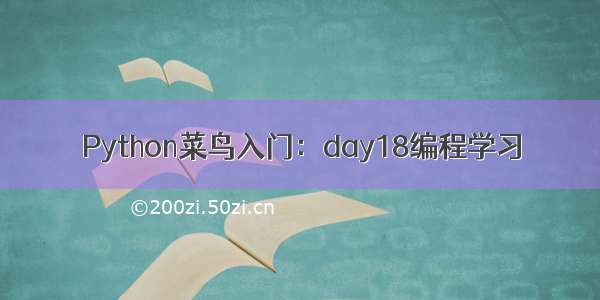
写在前面:
此博客仅用于记录个人学习进度,学识浅薄,若有错误观点欢迎评论区指出。欢迎各位前来交流。(部分材料来源网络,若有侵权,立即删除)
传送门:
day01基础知识
day02知识分类
day03运算符
day04数字与字符串
day05列表
day06元组与字典
day07条件与循环
day08函数概念
day09数据结构
day10模块介绍
day11文件操作
day12编程学习
day13编程学习
day14编程学习
day15编程学习
day16编程学习
day17编程学习
day18编程学习
Python学习:day18
实例编程学习06Python将列表中的指定位置的两个元素对调翻转列表判断元素是否在列表中存在清空列表复制列表计算元素在列表中出现的次数实例编程学习06
Python将列表中的指定位置的两个元素对调
对调第一个和第三个元素
def swapPositions(list, pos1, pos2):list[pos1], list[pos2] = list[pos2], list[pos1]return listList = [23, 65, 19, 90]pos1, pos2 = 1, 3print(swapPositions(List, pos1-1, pos2-1))
或
def swapPositions(list, pos1, pos2):first_ele = list.pop(pos1) second_ele = list.pop(pos2-1)list.insert(pos1, second_ele) list.insert(pos2, first_ele) return listList = [23, 65, 19, 90]pos1, pos2 = 1, 3print(swapPositions(List, pos1-1, pos2-1))
或
def swapPositions(list, pos1, pos2):get = list[pos1], list[pos2]list[pos2], list[pos1] = getreturn listList = [23, 65, 19, 90]pos1, pos2 = 1, 3print(swapPositions(List, pos1-1, pos2-1)
翻转列表
def Reverse(lst):return [ele for ele in reversed(lst)]lst = [10, 11, 12, 13, 14, 15]print(Reverse(lst))
输出结果:
或:
def Reverse(lst):lst.reverse()return lstlst = [10, 11, 12, 13, 14, 15]print(Reverse(lst))
输出结果:
或
def Reverse(lst):new_lst = lst[::-1]return new_lstlst = [10, 11, 12, 13, 14, 15]print(Reverse(lst))
输出结果:
或直接调用list列表的sort方法,设置reverse为True即可翻转列表:
li = [*range(10, 16)]# 得到列表 li = [10, 11, 12, 13, 14, 15], * 为解包符号print(li)# 降序排列li.sort(reverse = True)print(li)# 输出: [15, 14, 13, 12, 11, 10]
判断元素是否在列表中存在
from bisect import bisect_left # 初始化列表test_list_set = [ 1, 6, 3, 5, 3, 4 ]test_list_bisect = [ 1, 6, 3, 5, 3, 4 ]print("查看 4 是否在列表中 ( 使用 set() + in) : ")test_list_set = set(test_list_set)if 4 in test_list_set :print ("存在")print("查看 4 是否在列表中 ( 使用 sort() + bisect_left() ) : ")test_list_bisect.sort()if bisect_left(test_list_bisect, 4):print ("存在")
输出结果:
清空列表
zack = [6, 0, 4, 1]print('清空前:', zack) RUNOOB.clear()print('清空后:', zack)
输出结果:
复制列表
def clone_runoob(li1):li_copy = li1[:]return li_copyli1 = [4, 8, 2, 10, 15, 18]li2 = clone_runoob(li1)print("原始列表:", li1)print("复制后列表:", li2)
输出结果:
或
def clone_runoob(li1):li_copy = []li_copy.extend(li1)return li_copyli1 = [4, 8, 2, 10, 15, 18]li2 = clone_runoob(li1)print("原始列表:", li1)print("复制后列表:", li2)
输出结果:
或
def clone_runoob(li1):li_copy = list(li1)return li_copyli1 = [4, 8, 2, 10, 15, 18]li2 = clone_runoob(li1)print("原始列表:", li1)print("复制后列表:", li2)
输出结果:
计算元素在列表中出现的次数
def countX(lst, x):count = 0for ele in lst:if (ele == x):count = count + 1return countlst = [8, 6, 8, 10, 8, 20, 10, 8, 8]x = 8print(countX(lst, x))
或
def countX(lst, x):return lst.count(x)lst = [8, 6, 8, 10, 8, 20, 10, 8, 8]x = 8print(countX(lst, x))
end
明天还有最后一天的实训,弄完实训就向爬虫进发,希望明天也能坚持下来吧,加油。
















